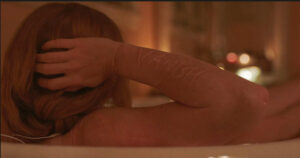“Sharp Objects” series – History Written on Skin [review]

Title: “Sharp Objects” (HBO series)
Release Date: 2018
Cast: Amy Adams, Sophia Lillis, Patricia Clarkson, Chris Messina, Elizabeth Perkins, Matt Craven, Taylor John Smith, Eliza Scanlen
The HBO miniseries “Sharp Objects” is a fascinating journey into a small American town where true evil lurks. At the same time, it is the main character’s journey to the truth about her own identity, literally written on the surface of her skin. The autography of the body and its decoding is the central metaphor of the film, bringing to mind Michel Foucault’s maxim: “the body – the surface of the record of events.”
“Sharp Objects” – evil lurks in the periphery
“Sharp Objects” is the story of a journalist, Camille Preaker (Amy Adams), who comes to her hometown to gather material for an article on two teenage girls, one of whom was murdered and the other disappeared. A visit to Wind Gap causes traumatic memories of her younger sister’s death, her mother’s frigidity and drastic relationships with her peers to resurface in the main character’s mind. It quickly becomes apparent that Camille’s mental problems and her addiction to alcohol are rooted in the past.
Taking place in the periphery, the plot of “Sharp Objects” constructs the space on the basis of the opposition between the center and the province. The big city, to which the main character has fled from difficult experiences, appears as a safe space – offering anonymity and refuge. The province in the series, on the other hand, harbors a small-town mentality, restriction and stigmatization of otherness by the local community. Moreover, it is in this small town that true evil erupts – someone starts murdering innocent girls.

Wind Gap from “Sharp Objects” is thus like the dark side of the human psyche, the subconscious, harboring all kinds of dark instincts and drives. As in Carl Gustav Jung’s psychoanalysis, Camille, in order to deal with her demons, must confront her inner shadow.
“Sharp Objects” and Skin Writing – identity written in the body
The story of the main character of the series “Sharp Objects” is revealed to the viewer in frequent flashbacks to different periods of her life. These excerpts are achronological – events from her childhood are interwoven with the quite recent past. This order reproduces the mechanisms of memory action, when a word or image evokes a specific memory. In “Sharp Objects”, nonetheless, this procedure acquires an additional, highly significant dimension. As it turns out, the chaotic nature of memories reflects the map of scars on Camille’s body.
The moment when the viewer learns about the practice of self-mutilation that the main character undergoes seems key to the entire series. Of course, in the first place, this behavior has a psychological aspect. Scarification of the body is an expression of Camille’s self-aggression, as she punishes herself for the alleged guilt with which her mother constantly burdens her. When she disapprovingly comments, for example, on the girl’s red dress with the contemptuous comparison of it to a cherry, the teenager engraves the word with a needle on her body. Cutting one’s own skin also has a relaxing dimension – focusing on pain provides a temporary escape from problems. In Camille’s case, the practice also has a stimulating function.

Nevertheless, another meaning of skinwriting seems most interesting. “Sharp Objects” show, namely, how the body becomes the foundation of human identity. The series can be interpreted in the context of corporate feminism. This current is a clear opposition to philosophy based on the Cartesian vision of the subject. For while Descartes (the famous “I think, therefore I am”) reduced the subject to pure mind, thinkers such as Elisabeth Grosz, for example, promote the opposite claim. It is the body that is the basis of human experience, its role is not limited to that of a vehicle for the mind and soul, as the body in general makes existence possible.
Autography in “Sharp Objects” – the body as text
Human identity is built on the basis of a particular body – gender, appearance, certain illnesses – all these experiences of the body imprint the psyche. Furthermore, the body becomes the surface on which every significant experience is recorded. This is what happens in the case of Camille – her skin is transformed into a living text. The autography of the heroine of Sharp Objects is a message coming from within. Identity formation is thus a process of recording experiences in the body, and understanding oneself and others involves decoding these signs.
In this context, the scene when Camille enters into an erotic relationship with John Keen (Taylor John Smith) is particularly significant. It is this young boy who notices the scars on the woman’s skin and then reads the various inscriptions. Contact with the body text becomes the same as touching Camille’s soul, which is why it is John, not Detective Richard (Chris Messina), who comes closest to the heroine. Reading the story written on the skin also becomes an act of release from trauma for Camille. Overcoming one’s own isolation is accomplished by exposing the body, mutilated by the past, and therefore the tormented soul of which it is a sign.

In “Sharp Objects”, the body is the surface on which internal processes and external experiences are recorded. Although it is biological in nature, it is subject to constant shaping by culture. This is evident in the scene when Camille, hiding her scars under a layer of dark clothes, is forced by her mother holding a feast for the residents to wear an ethereal white dress. The main character’s sister, Amma (Eliza Scanlen), on the other hand, manipulates her identity with the help of her outfit. She assumes the role of a good daughter by using genteel dresses and bows; short shorts, makeup and disheveled hair, on the other hand, make her a cool girl. The body, then, is the most legible sign of identity and, like her, is subject to styling by certain social and cultural influences.
The series “Sharp Objects” touches on the trauma of femininity
“Sharp Objects” is a series in which female characters undoubtedly come to the fore. Men definitely remain in their shadow. Femininity here is not homogeneous, on the contrary, each of the heroines is a unique individuality. Camille’s mother, Adora (Patricia Clarkson), is an elegant lady who, underneath her impeccable manners, hides an extremely strong personality striving for power and domination. Indeed, Adora controls not only members of her immediate family, but the entire city. She uses for this purpose both her position as the most influential resident of Wind Gap and emotional blackmail.
Jackie (Elizabeth Perkins), Adora’s friend, on the other hand, is an artistic, sensitive soul who unwinds her failures in alcohol. Separate portraits are, of course, Camille and her younger sister Amma. The gallery of female characters is completed by the main character’s female friends from her youth.
Just as important as the images of the women are the relationships between them. They oscillate between love (sometimes morbid – as in the case of Adora’s mother), friendship, and jealousy and cruelty. “Sharp Objects” particularly expose the predatory side of femininity. It is no coincidence that the most destructive behaviors are displayed by women in this series. And what’s more, these are patterns that are, as it were, inherited in the family and perpetuated in a small community. It is noteworthy that Adora’s psychological violence against her daughters is rooted in her traumatic relationship with her mother.

The trauma burdened on the women in “Sharp Objects” goes even deeper – all the way back to Wind Gap’s roots, as shown in an episode of the series in which the town celebrates a holiday commemorating the heroic act of Adora’s great-grandmother during the Civil War. At the time, the woman saved hiding Confederate soldiers from death by exposing herself to a gang rape. It is significant that this scene is repeated in Camille’s story – as a victim of sexual violence. Similarly, the motif of peculiar female aggression is duplicated in the case of the ivory floor in Adora’s house. This is because it finds its macabre reflection in the miniature house built by Amma. In both situations, the floor serves as a kind of trophy.
“Sharp Objects” – masculinity through the eyes of a woman
The men in “Sharp Objects” are situated in the background, and what’s more, they seem somewhat dominated by the women. The best example is Adora’s husband, reduced almost to the role of decoration in his wife’s huge house. His isolation, but also his deliberate abdication of responsibility for what is going on in the family, is emphasized by the headphones on his ears. With them, Alan (Henry Czerny) escapes into his own world and drowns out reality with the sounds of music. A representative of the local authority in turn, the commandant in charge of the investigation (Matt Craven), succumbs to manipulation by Adora, with whom he shares a vague erotic relationship. Another significant male character, Detective Richard Willis, succumbs to Camille’s fascination, which over time prevents him from conducting the investigation coolly and factually.
Particularly notable here are the erotic scenes depicting the relationship between the law enforcer and the main character. Namely, we have here a reversal of the traditional way of filming sex. The camera reflects the gaze of a woman rather than a man. This is because the classic convention of showing love scenes implies filming the nakedness of a woman, it is primarily her body that concentrates sexual meanings. Meanwhile, in “Sharp Objects” we observe a naked man and a completely covered woman. Moreover, it is clearly implied here that the act of love is meant to give fulfillment mainly to Camille, who almost selfishly wants to satisfy her desire. It is significant that there is no full rapprochement between these characters. This peculiar defect of physical intimacy with Richard translates into a deficit of a deeper bond with the man. For it is John, not the detective, who experiences the privilege of seeing Camille’s mutilated skin and completely uniting with her in a sexual act. The body therefores once again proves to be “the surface of the record of events.”
“Sharp Objects” – meaning of the title
The title of the series itself is ambiguous to say the least. For sharp objects are the leitmotiv of Camille’s inner visions. They are arranged in peculiar sequences: a fork, a needle, a razor blade – all these attract the attention of the main character, because they can become tools for marking the skin. “Sharp objects,” however, also include pliers, with which the murderer pulls the teeth of his victims. Sharp objects are therefore a sign of aggression, which can be directed inward, as in Camille’s case, or to the world, resulting in gruesome crimes.
The series has an eerie, heavy atmosphere of a small hermetic community. It doesn’t let the viewer rest even for a moment, making him like in Dante’s Divine Comedy descend into lower and lower circles of hell. Nor does it offer consolation; on the contrary, it leaves the viewer helpless in the face of the evil revealed.
Literature:
E. Hyży, “Kobieta, ciało, tożsamość. Teorie podmiotu w filozofii feministycznej końca XX wieku”, Kraków 2003.
